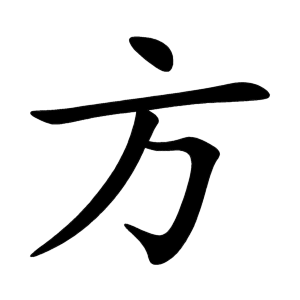方
- square;
- direction;
Etymology
方 is a pictogram derived from the shape of a plow with handles on both sides. Because two people would carry it, meanings such as left and right (左右), arranging things in a line, and comparing arose. From these, the meanings expanded to include direction, method, and various others.
The origin of the character 方 is also said to be from two log boats placed side by side, or it is sometimes described as resembling a cross-shaped figure similar to a crucifix.
Derived characters
According to the Shuowen Jiezi, the character 㫃 (a fluttering flag shape, pronounced "eon") was once treated as a separate radical, but later reanalyzed as 方 + 人 and merged under the 方 radical.
As a result, characters that use 方 as a radical often carry meanings related to “flags” rather than the more common modern interpretation of “direction.”
Examples of such characters include:
旁 (side, bang)
於 (a classical particle, eo)
斺 (to bind, gae)
旀 (moreover, myeo)
旔 (swift, geon)
Notably, 於 originally comes from an alternate form of 烏 (crow, o) and is not structurally or semantically related to 方 or 㫃, despite appearances.
Characters with 方
Words that derived from 方
- 동방(東方)–east
- 방법(方法)–way; means; manner
- 방법론(方法論)–method; methodology
- 방언(方言)–regional dialect; vernacular
- 방위(方位)–bearing; point of the compass
- 방향(方向)–direction; side; way
- 방향성(方向性)–being directional; directionality
- 북방(北方)–north
- 상대방(相對方)–counterpart; the other person
- 지방(地方)–area; district; provinces; countryside
- 처방(處方)–prescription; remedy
- 행방(行方)–whereabouts
- 후방(後方)–rear; back
- 卜竹尸 (YHS)
- ⿱ 丶 万
